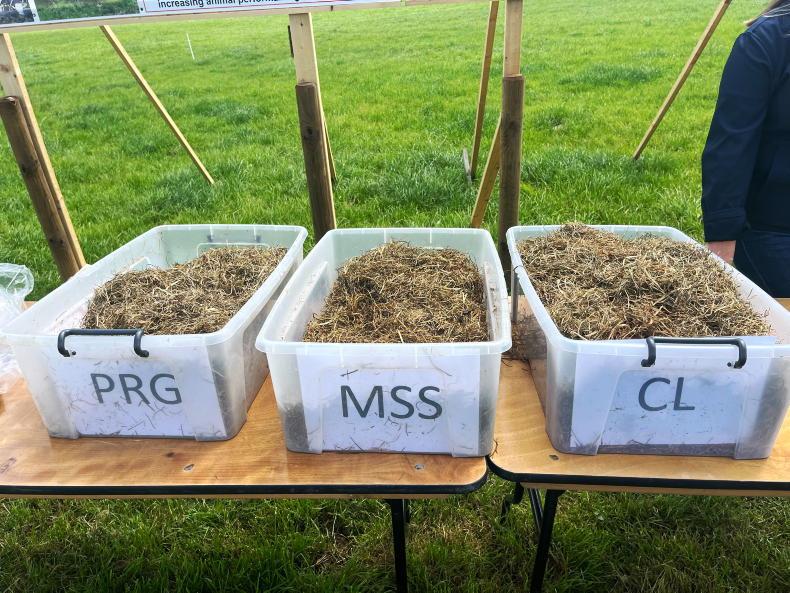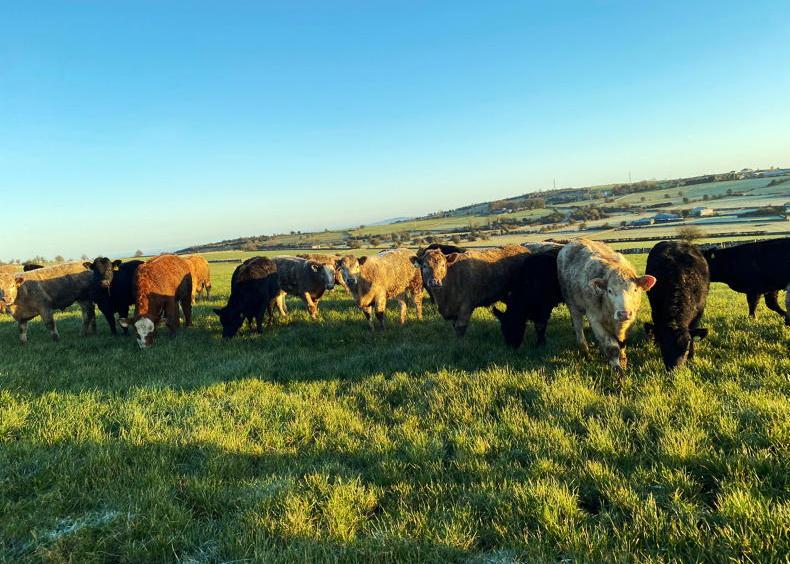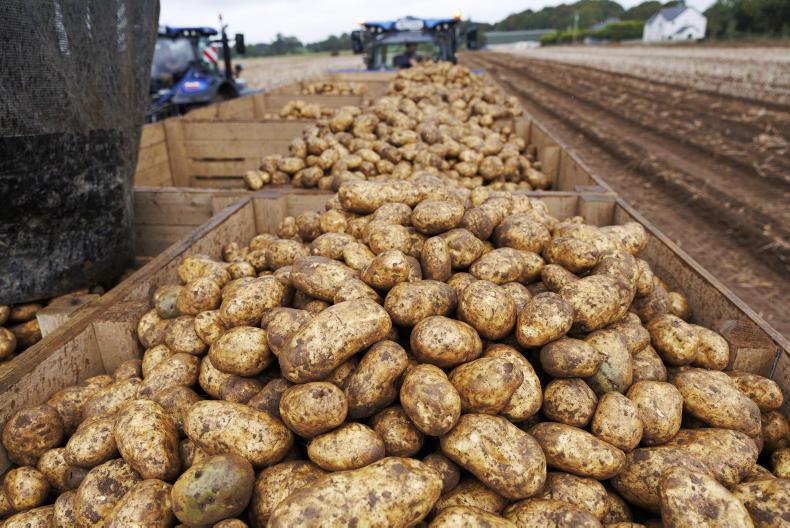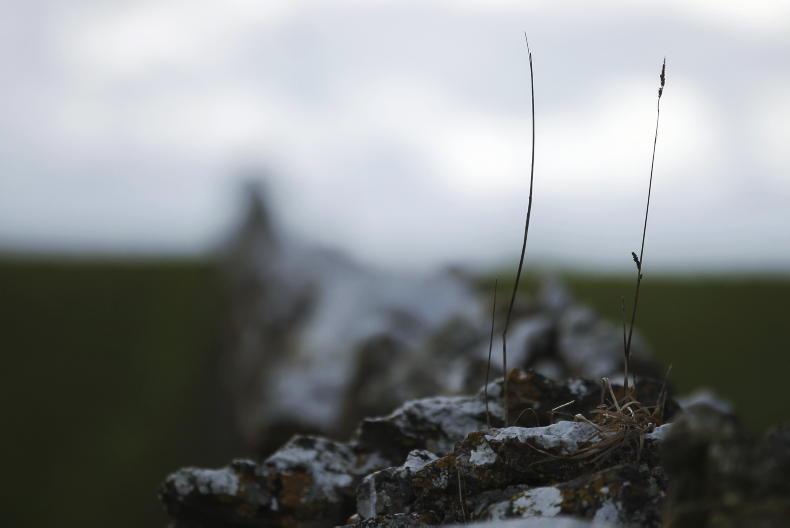Beef trial at Johnstown Castle
In 2021 and 2022, Teagasc Johnstown Castle purchased over 100 dairy beef heifer calves each year and assigned the animals to one of three grazing treatments based on sward make-up.
The treatments were grass only getting 150kg N/ha, grass/clover getting 75kg N/ha and multispecies also getting 75kg N/ha of chemical nitrogen.
Researcher Ellen Fitzpatrick ran the experiment looking at daily liveweight gain, age at slaughter, carcase weight and conformation, net margin and carbon footprint of the different systems.
Ellen says the calves purchased were not selected based on high genetic merit for beef and this is important when looking at the figures.
In terms of age at slaughter, the heifers on the perennial ryegrass-only treatment took longest to kill at 19.6 months of age while the heifers on the grass/clover and multispecies were slaughtered at 19.2 months of age.
Carcase weight was 243kg, 250kg and 249kg respectively for the grass only, grass/clover and multispecies treatments.
Three grazing systems
There was no difference in conformation between each of the treatments with O= achieved across all three grazing systems. Carcase fat averaged 3= for the grass only group and 3=/+ for both the clover and multispecies groups.
Ellen says that the average daily gain of the calves was much higher for the heifers on the multispecies in year one at 0.79kg/day compared to 0.61kg/day and 0.62kg/day for the grass and clover treatments respectively.
This did balance out by the time the heifers were slaughtered at the end of the second grazing season with average daily gain of 0.81kg/day, 0.92kg/day and 0.87kg/day for the grass, clover and multispecies treatments respectively.
Ellen suggests that the higher gain for calves in year one on the multispecies could be to do with the fact that there is more fibre in the sward and this may be what the calves need as their rumens develop.
Pauric’s research plans
Researcher Pauric Coleman is continuing the study but this time is focusing more on the animals in the grazing study.
There are 120 heifers purchased each year, half are early maturing breeds such as Hereford and Angus and the other half are late maturing Belgian Blue and Limousin.
Animals are grazed on the three pasture treatments as already described but are finished at different ages of 17, 19 and 21 months of age.

Silage samples from each of the treatments on the beef study.
The 21 month old group will be re-housed in the second winter on a 60 day finishing period.
According to Pauric, the research will help to develop a blueprint for profitable dairy beef heifer systems in Ireland.
He says that while heifers may have lower carcase weights, the fact that most can be slaughtered before the second winter means that the stocking rate can be higher leading to very good output per hectare.
Dairy trial at Johnstown Castle
Between 2020 and 2023 Teagasc ran a trial with spring calving dairy cows in Johnstown Castle looking at performance on grass/clover swards and multispecies swards.
Half of the 40 cows have been grazing grass/clover swards and the other half grazing multispecies swards.
All of the swards were fully reseeded in 2019 and that fact is probably reflected in the performance of the farmlets, which definitely dipped as time went on.
The headline figures are that the grass/clover swards grew 13.98t DM/ha from 162kg N/ha of applied nitrogen on average over the four years.
The multispecies swards, consisting of six species (perennial ryegrass, timothy grass, chicory, plantain, red and white clover) grew an average of 12.75t DM/ha from an average of 58kg N/ha of applied nitrogen.

Orla Mattimoe is a PhD student working on the dairy research at Johnstown Castle.
In 2020 and 2021, the grass/clover swards grew 15.2t DM/ha in each year from 234kg and 155kg N/ha respectively while the multispecies swards grew 13.7t DM/ha in each year from 82kg and 64kg N/ha respectively.
In 2023, the grass/clover yield was down to 12.6t DM/ha from 116kg N/ha while the multispecies yield was down to 10.7t DM/ha from just 31kg N/ha.
There are obviously year effects as 2023 was a poor year for grass growth and 2024 is shaping up to be the same.
There was no difference in milk solids performance between the two farmlets with each herd delivering around 540kg MS/cow on average over the four years.
Future plans
The team at Johnstown Castle are continuing with the experiment for 2024 and 2025 but this time looking to evaluate multispecies swards and grass/clover swards in intensive grazing systems that are self-sufficient for forage. In the previous study, neither the grass/clover nor the multispecies swards were self-sufficient for winter feed.
The current experiment involves 36 cows split into two groups of 18 with each group grazing a farmlet of 7.55ha giving a stocking rate of 2.37 cows/ha.

Some of the dairy beef heifers at Johnstown Castle.
The same swards as those sown in 2019 are being used in this study, but 30% of each farmlet was reseeded in 2023.
In addition, the researchers will look at the impact of sward type and urine application on nitrogen losses across a range of soil types using lysimeters at Johnstown Castle. They will also look at the carbon footprint of the different systems.
According to PhD student Orla Mattimoe, 29% of each farmlet was cut for first cut silage this year and the plan is to get the remainder of the silage required as and when surpluses appear.
Current performance
In terms of current performance, at the open day in mid-July the cows on the grass/clover treatment had produced 289kg MS/cow while the cows on the multispecies treatment had produced 278kg MS/cow.
Meal feeding rates were the same between both treatments at 616kg meal per cow.
The grass/clover swards had grown 7.3t DM/ha while the multispecies had grown 6.5t DM/ha – a difference of 0.8t DM/ha.
The grass/clover swards had received 97kg N/ha out of a maximum of 120kg N/ha and the multispecies swards had received 55kg N/ha out of a maximum of 60kg N/ha.
There was 2.8t DM/ha silage produced to date from the grass/clover swards and 2.4t DM/ha produced from the multispecies swards.
The highest net margin was achieved in the grass/clover group at €1,097/ha followed by the multispecies group at €1,050/ha and then the grass group at €950/ha.
In brief
Johnstown Castle researchers are doing systems experiments on dairy and beef animals grazing ryegrass and white clover swards and multispecies swards. On the dairy experiment, there were similar levels of animal performance across the treatments, but the multispecies swards grew less grass but also received significantly less chemical nitrogen. The dairy beef experiment found that performance on the multispecies was similar to that of the grass and clover treatment and both were better than grass only. Animals in their first year performed very well on the multispecies swards. Over the four year period the difference in grass yield between the two farmlets on the dairy study is 1.23t DM/ha. At a stocking rate of 2.6 cows/ha, that’s 473kg of feed per cow or about two round bales of silage per cow of a difference between the more conventional grass and clover swards and multispecies.
Using simple maths at €40/bale that’s €80/cow or €208/ha of an additional feed cost. There was 104kg N/ha less nitrogen applied to the multispecies swards. At €1.10/kg of N the savings in nitrogen equated to €114/ha so the difference is about €94/ha.
The question could be asked why the difference in nitrogen between the two farmlets?
There was around 20% clover content in the multispecies swards in summer 2023 and we presume similar clover content in the grass/clover swards at the same time.
So based on this, both the farmlets could have or should have received the same level of N. What is the correct level of N is another question – is it 162kg or 58kg N/ha?
From a farmer or even research point of view, it’s difficult to draw conclusions on multispecies based on the initial trial.
Beef trial at Johnstown Castle
In 2021 and 2022, Teagasc Johnstown Castle purchased over 100 dairy beef heifer calves each year and assigned the animals to one of three grazing treatments based on sward make-up.
The treatments were grass only getting 150kg N/ha, grass/clover getting 75kg N/ha and multispecies also getting 75kg N/ha of chemical nitrogen.
Researcher Ellen Fitzpatrick ran the experiment looking at daily liveweight gain, age at slaughter, carcase weight and conformation, net margin and carbon footprint of the different systems.
Ellen says the calves purchased were not selected based on high genetic merit for beef and this is important when looking at the figures.
In terms of age at slaughter, the heifers on the perennial ryegrass-only treatment took longest to kill at 19.6 months of age while the heifers on the grass/clover and multispecies were slaughtered at 19.2 months of age.
Carcase weight was 243kg, 250kg and 249kg respectively for the grass only, grass/clover and multispecies treatments.
Three grazing systems
There was no difference in conformation between each of the treatments with O= achieved across all three grazing systems. Carcase fat averaged 3= for the grass only group and 3=/+ for both the clover and multispecies groups.
Ellen says that the average daily gain of the calves was much higher for the heifers on the multispecies in year one at 0.79kg/day compared to 0.61kg/day and 0.62kg/day for the grass and clover treatments respectively.
This did balance out by the time the heifers were slaughtered at the end of the second grazing season with average daily gain of 0.81kg/day, 0.92kg/day and 0.87kg/day for the grass, clover and multispecies treatments respectively.
Ellen suggests that the higher gain for calves in year one on the multispecies could be to do with the fact that there is more fibre in the sward and this may be what the calves need as their rumens develop.
Pauric’s research plans
Researcher Pauric Coleman is continuing the study but this time is focusing more on the animals in the grazing study.
There are 120 heifers purchased each year, half are early maturing breeds such as Hereford and Angus and the other half are late maturing Belgian Blue and Limousin.
Animals are grazed on the three pasture treatments as already described but are finished at different ages of 17, 19 and 21 months of age.

Silage samples from each of the treatments on the beef study.
The 21 month old group will be re-housed in the second winter on a 60 day finishing period.
According to Pauric, the research will help to develop a blueprint for profitable dairy beef heifer systems in Ireland.
He says that while heifers may have lower carcase weights, the fact that most can be slaughtered before the second winter means that the stocking rate can be higher leading to very good output per hectare.
Dairy trial at Johnstown Castle
Between 2020 and 2023 Teagasc ran a trial with spring calving dairy cows in Johnstown Castle looking at performance on grass/clover swards and multispecies swards.
Half of the 40 cows have been grazing grass/clover swards and the other half grazing multispecies swards.
All of the swards were fully reseeded in 2019 and that fact is probably reflected in the performance of the farmlets, which definitely dipped as time went on.
The headline figures are that the grass/clover swards grew 13.98t DM/ha from 162kg N/ha of applied nitrogen on average over the four years.
The multispecies swards, consisting of six species (perennial ryegrass, timothy grass, chicory, plantain, red and white clover) grew an average of 12.75t DM/ha from an average of 58kg N/ha of applied nitrogen.

Orla Mattimoe is a PhD student working on the dairy research at Johnstown Castle.
In 2020 and 2021, the grass/clover swards grew 15.2t DM/ha in each year from 234kg and 155kg N/ha respectively while the multispecies swards grew 13.7t DM/ha in each year from 82kg and 64kg N/ha respectively.
In 2023, the grass/clover yield was down to 12.6t DM/ha from 116kg N/ha while the multispecies yield was down to 10.7t DM/ha from just 31kg N/ha.
There are obviously year effects as 2023 was a poor year for grass growth and 2024 is shaping up to be the same.
There was no difference in milk solids performance between the two farmlets with each herd delivering around 540kg MS/cow on average over the four years.
Future plans
The team at Johnstown Castle are continuing with the experiment for 2024 and 2025 but this time looking to evaluate multispecies swards and grass/clover swards in intensive grazing systems that are self-sufficient for forage. In the previous study, neither the grass/clover nor the multispecies swards were self-sufficient for winter feed.
The current experiment involves 36 cows split into two groups of 18 with each group grazing a farmlet of 7.55ha giving a stocking rate of 2.37 cows/ha.

Some of the dairy beef heifers at Johnstown Castle.
The same swards as those sown in 2019 are being used in this study, but 30% of each farmlet was reseeded in 2023.
In addition, the researchers will look at the impact of sward type and urine application on nitrogen losses across a range of soil types using lysimeters at Johnstown Castle. They will also look at the carbon footprint of the different systems.
According to PhD student Orla Mattimoe, 29% of each farmlet was cut for first cut silage this year and the plan is to get the remainder of the silage required as and when surpluses appear.
Current performance
In terms of current performance, at the open day in mid-July the cows on the grass/clover treatment had produced 289kg MS/cow while the cows on the multispecies treatment had produced 278kg MS/cow.
Meal feeding rates were the same between both treatments at 616kg meal per cow.
The grass/clover swards had grown 7.3t DM/ha while the multispecies had grown 6.5t DM/ha – a difference of 0.8t DM/ha.
The grass/clover swards had received 97kg N/ha out of a maximum of 120kg N/ha and the multispecies swards had received 55kg N/ha out of a maximum of 60kg N/ha.
There was 2.8t DM/ha silage produced to date from the grass/clover swards and 2.4t DM/ha produced from the multispecies swards.
The highest net margin was achieved in the grass/clover group at €1,097/ha followed by the multispecies group at €1,050/ha and then the grass group at €950/ha.
In brief
Johnstown Castle researchers are doing systems experiments on dairy and beef animals grazing ryegrass and white clover swards and multispecies swards. On the dairy experiment, there were similar levels of animal performance across the treatments, but the multispecies swards grew less grass but also received significantly less chemical nitrogen. The dairy beef experiment found that performance on the multispecies was similar to that of the grass and clover treatment and both were better than grass only. Animals in their first year performed very well on the multispecies swards. Over the four year period the difference in grass yield between the two farmlets on the dairy study is 1.23t DM/ha. At a stocking rate of 2.6 cows/ha, that’s 473kg of feed per cow or about two round bales of silage per cow of a difference between the more conventional grass and clover swards and multispecies.
Using simple maths at €40/bale that’s €80/cow or €208/ha of an additional feed cost. There was 104kg N/ha less nitrogen applied to the multispecies swards. At €1.10/kg of N the savings in nitrogen equated to €114/ha so the difference is about €94/ha.
The question could be asked why the difference in nitrogen between the two farmlets?
There was around 20% clover content in the multispecies swards in summer 2023 and we presume similar clover content in the grass/clover swards at the same time.
So based on this, both the farmlets could have or should have received the same level of N. What is the correct level of N is another question – is it 162kg or 58kg N/ha?
From a farmer or even research point of view, it’s difficult to draw conclusions on multispecies based on the initial trial.












SHARING OPTIONS